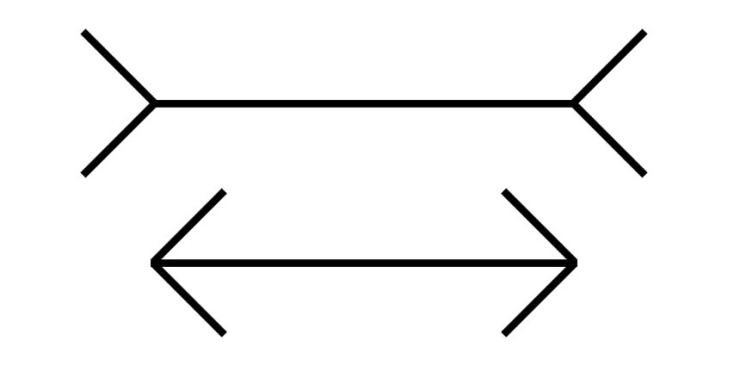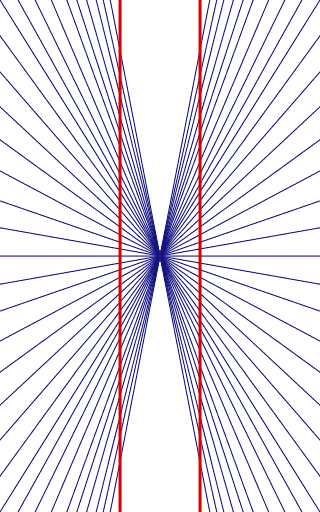We don't always see what we think we see.
Artists have been translating their visual perceptions of the three-dimensional world onto flat surfaces for about 40,000 years, the time of the earliest cave paintings.
Most of us are used to viewing our world in a linear fashion. In America, and other industrialized countries, we build rectangle-shaped houses, with rectangular rooms and rectangular gardens. We have some winding highways, but the roads of our cities and towns are usually formed by grids.
When Americans are shown the Mueller-Lyer Illusion, made up of two parallel lines, one with fins facing inward, the other with fins facing out, most Americans say that the line with the outward facing fins is larger that the other line.
The two creative expressions of man, art and science, meet again to form an imaginary construct that is in accord with our sensibility and contemporary knowledge."
-Victor Vasarely
When the same illusion is shown to people who live in more remote places, like the Kalahari Desert, whose homes are rondavels, and who travel on paths cut through the brush, they see the lines as they are…the same length.
When we walk into a room, we expect the walls to be parallel, the floor to be level and parallel to the ceiling. One of the best examples of what happens when our expectations and our perceptions collide, is the Ames Room, invented by ophthalmologist, Adelbert Ames, Jr. in 1934.
The Ames Room is a trapezoid, with slanting floor and ceiling. When viewed through a hole in the front wall, it appears to be an ordinary room. One of the amazing things about this illusion is that, even when we know how it works, once we see it, we can't go back and un-see it.
The fact that our visual illusions are caused either by our optical perceptions or our learned world view, has been studied by scientists, like the Greek polymath, Ptolemy, in 100 A.D. and the Egyptian scholar, Alhazen around 1000 A.D.
One of the scientists who pushed forward the study of optics and visual perception, was Hermann von Helmholtz, a German physician and physicist who published The Handbook of Physiological Optics or Treatise on Physiological Optics in 1867. Helmholtz described the way in which we perceive things with what he termed unconscious inference. An example he gave is watching a young actor we know play the part of an old man. We know we are watching a young actor, but we allow ourselves to view him as an old man and even invest our emotions in his performance. We do the same thing with optical illusions.
The German physiologist, Ewald Hering, did research on optical perception and discovered the Hering Illusion. Hering found that when two straight and parallel lines are placed in front of a radial background, the lines appear to bow outwards.
While scientists were studying visual perception, philosophers and psychologists were studying the psychology of perception. The idea of Gestalt psychology, which took hold in the early 20th century, is that we look at the world and our minds organize what we see within the framework of our own reality.
Victor Vasarley was a young medical student in Hungary in 1925. After two years of study, Vasarely left medical school to study art at the the Podolini-Volkmann Academy and then at the Bauhaus.
Although trained in traditional painting, Vasarely continued to read scientific materials and combined his knowledge of both. "The two creative expressions of man, art and science," he said, "meet again to form an imaginary construct that is in accord with our sensibility and contemporary knowledge."
By combining art and science in his work, exploring depth and movement, Vasarely became the father of "Op Art". We have some of fine examples of Victor Vasarely's artwork work in our gallery, including several that are based on his "Alphabet Plastique" which combined variations of the circle, square and triangle with 20 hues from different color scales.







